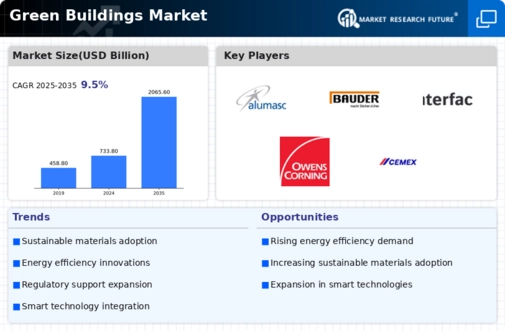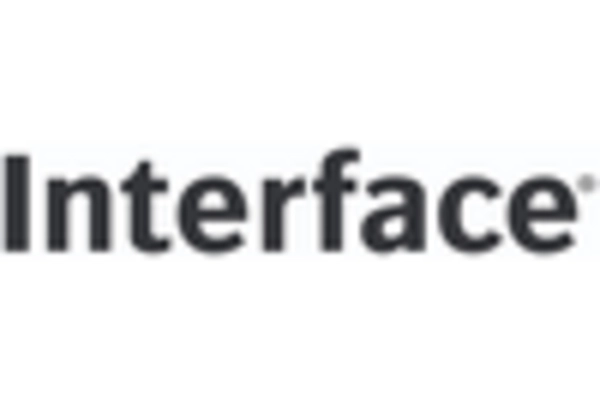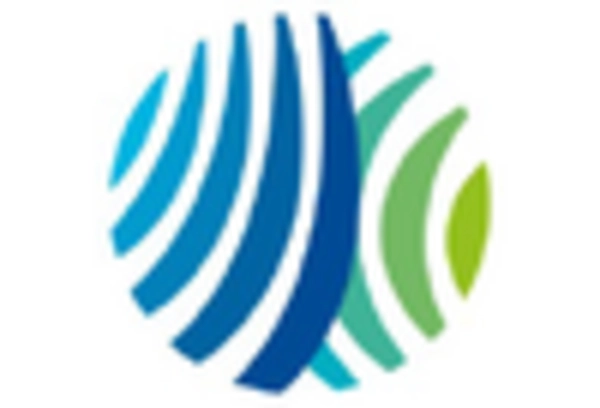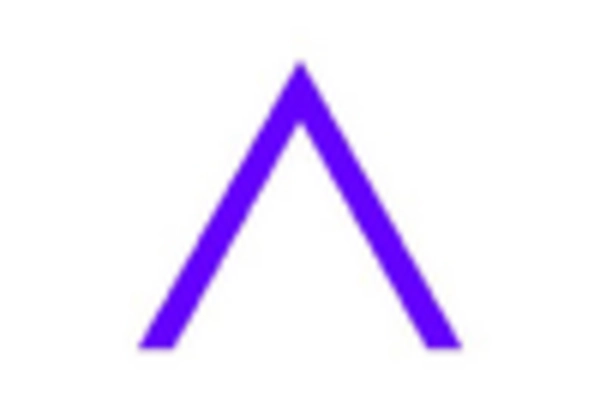-
Executive Summary
-
Market Introduction
-
Definition 16
-
Scope of the Study 16
-
List of Assumptions 16
-
Market Structure 17
-
Key Takeaways 17
-
Key Buying Criteria 18
-
Research Methodology
-
Research Process 20
-
Primary Research 20
-
Secondary Research 21
-
Market Size Estimation 22
-
Forecast Model 23
-
Market Dynamics
-
Introduction 25
-
Drivers 25
- Growing Green Building Concept 25
- Managing the Cost of Green Buildings 26
- Higher Rents and Values 26
- Impact on Workplace Productivity and Health 26
- Drivers Impact Analysis 27
-
Restraints 27
- Delays in obtaining certification and permits 27
- Restraints Impact Analysis 27
-
Opportunity 28
- Sustainability in Emerging Economies & the Developing World 28
-
Market Factor Analysis
-
Supply Chain Analysis 30
- Material acquisition 30
- Components Design 30
- Construction/retrofitting 30
- Facilities management 31
-
Porter’s Five Forces Model 31
- Threat of New Entrants 31
- Bargaining Power of Suppliers 31
- Bargaining Power of Buyers 32
- Threat of Substitutes 32
- Intensity of Rivalry 32
-
Policy Initiatives for Green Building in India 32
-
Tax Incentives for Green Buildings 33
- Government of India 33
- State Government/Local Bodies 33
- Financial Institutions 33
-
Global Green Building Market, By Product
-
Overview 35
- Exterior Products 35
- Interior Products 35
-
Global Green Building Market, By Application
-
Overview 38
- Residential 38
- Non-Residential 38
-
Global Green Building Market, By Region
-
Introduction 41
-
North America 43
- U.S. 44
- Canada 45
- Mexico 46
-
Europe 47
- Germany 48
- U.K. 49
- Norway 50
- Poland 50
- France 51
- Rest of Europe 52
-
Asia Pacific 53
- China 55
- Japan 55
- India 56
- South Korea 57
- Australia 58
- Singapore 58
- Hong Kong 59
- Rest of Asia Pacific 60
-
Middle East & Africa 61
- Middle East 62
- Africa 62
-
Competitive Landscape
-
Company Profiles
-
E. I. du Pont de Nemours and Company 67
- Company Overview 67
- Financial Overview 67
- Products Offerings 68
- Key Strategy 68
- SWOT Analysis 68
-
Saint Global S.A. 69
- Company Overview 69
- Financial Overview 69
- Products Offerings 70
- Key Strategy 70
- SWOT Analysis 71
-
Wienerberger AG 72
- Company Overview 72
- Financial Overview 72
- Products Offerings 72
- Key Strategy 72
- SWOT Analysis 73
-
SGS 74
- Company Overview 74
- Financial Overview 74
- Products Offerings 74
- Key Strategy 74
- SWOT Analysis 75
-
Kingspan Group Plc. 76
- Company Overview 76
- Financial Overview 76
- Products Offerings 77
- Key Strategy 77
- SWOT Analysis 77
-
Bauder 78
- Company Overview 78
- Financial Overview 78
- Products Offerings 78
- Key Strategy 78
-
NATiVE 79
- Company Overview 79
- Financial Overview 79
- Products Offerings 79
- Key Strategy 80
-
Green Building Store 81
- Company Overview 81
- Financial Overview 81
- Products Offerings 81
- Key Strategy 81
-
Ginkgo Sustainability Inc. 82
- Company Overview 82
- Financial Overview 82
- Products Offerings 82
- Key Strategy 82
-
Green Build Products (I) Pvt Ltd 83
- Company Overview 83
- Financial Overview 83
- Products Offerings 83
- Key Strategy 83
-
Conclusion
-
Key Findings 85
- Key Companies to Watch 85
- Prediction 85
-
Appendix
-
List of Tables
-
MARKET SYNOPSIS 14
-
LIST OF ASSUMPTIONS 16
-
GLOBAL GREEN BUILDING MARKET SIZE, BY PRODUCT, 2020-2027 (USD MILLION) 36
-
GLOBAL GREEN BUILDING MARKET, BY APPLICATION, 2020-2027 (USD MILLION) 39
-
GLOBAL GREEN BUILDING MARKET, BY REGION, 2020-2027 (USD MILLION) 42
-
NORTH AMERICA: GREEN BUILDING MARKET, BY COUNTRY, 2020-2027 (USD MILLION) 43
-
NORTH AMERICA: GREEN BUILDING MARKET, BY PRODUCT, 2020-2027 (USD MILLION) 43
-
NORTH AMERICA: GREEN BUILDING MARKET, BY APPLICATION, 2020-2027 (USD MILLION) 44
-
U.S.: GREEN BUILDING MARKET, BY PRODUCT, 2020-2027 (USD MILLION) 44
-
U.S.: GREEN BUILDING MARKET, BY APPLICATION, 2020-2027 (USD MILLION) 44
-
CANADA: GREEN BUILDING MARKET, BY PRODUCT, 2020-2027 (USD MILLION) 45
-
CANADA: GREEN BUILDING MARKET, BY APPLICATION, 2020-2027 (USD MILLION) 45
-
MEXICO: GREEN BUILDING MARKET, BY PRODUCT, 2020-2027 (USD MILLION) 46
-
MEXICO: GREEN BUILDING MARKET, BY APPLICATION, 2020-2027, (USD MILLION) 46
-
EUROPE: GREEN BUILDING MARKET, BY COUNTRY, 2020-2027 (USD MILLION) 47
-
EUROPE: GREEN BUILDING MARKET, BY PRODUCT, 2020-2027 (USD MILLION) 48
-
EUROPE: GREEN BUILDING MARKET, BY APPLICATION, 2020-2027 (USD MILLION) 48
-
GERMANY: GREEN BUILDING MARKET, BY PRODUCT, 2020-2027 (USD MILLION) 48
-
GERMANY: GREEN BUILDING MARKET, BY APPLICATION, 2020-2027 (USD MILLION) 49
-
U.K.: GREEN BUILDING MARKET, BY PRODUCT, 2020-2027 (USD MILLION) 49
-
U.K.: GREEN BUILDING MARKET, BY APPLICATION, 2020-2027 (USD MILLION) 49
-
NORWAY: GREEN BUILDING MARKET, BY PRODUCT, 2020-2027 (USD MILLION) 50
-
NORWAY: GREEN BUILDING MARKET, BY APPLICATION, 2020-2027 (USD MILLION) 50
-
POLAND: GREEN BUILDING MARKET, BY PRODUCT, 2020-2027 (USD MILLION) 51
-
POLAND: GREEN BUILDING MARKET, BY APPLICATION, 2020-2027 (USD MILLION) 51
-
FRANCE: GREEN BUILDING MARKET, BY PRODUCT, 2020-2027 (USD MILLION) 51
-
FRANCE: GREEN BUILDING MARKET, BY APPLICATION, 2020-2027 (USD MILLION) 52
-
REST OF EUROPE: GREEN BUILDING MARKET, BY PRODUCT, 2020-2027 (USD MILLION) 52
-
REST OF EUROPE: GREEN BUILDING MARKET, BY APPLICATION, 2020-2027 (USD MILLION) 52
-
ASIA PACIFIC: GREEN BUILDING MARKET, BY COUNTRY, 2020-2027 (USD MILLION) 53
-
ASIA PACIFIC: GREEN BUILDING MARKET, BY PRODUCT, 2020-2027 (USD MILLION) 54
-
ASIA PACIFIC: GREEN BUILDING MARKET, BY APPLICATION, 2020-2027 (USD MILLION) 54
-
CHINA: GREEN BUILDING MARKET, BY PRODUCT, 2020-2027 (USD MILLION) 55
-
CHINA: GREEN BUILDING MARKET, BY APPLICATION, 2020-2027 (USD MILLION) 55
-
JAPAN: GREEN BUILDING MARKET, BY PRODUCT, 2020-2027 (USD MILLION) 56
-
JAPAN: GREEN BUILDING MARKET, BY APPLICATION, 2020-2027 (USD MILLION) 56
-
INDIA: GREEN BUILDING MARKET, BY PRODUCT, 2020-2027 (USD MILLION) 56
-
INDIA: GREEN BUILDING MARKET, BY APPLICATION, 2020-2027 (USD MILLION) 57
-
SOUTH KOREA: GREEN BUILDING MARKET, BY PRODUCT, 2020-2027 (USD MILLION) 57
-
SOUTH KOREA: GREEN BUILDING MARKET, BY APPLICATION, 2020-2027 (USD MILLION) 57
-
AUSTRALIA: GREEN BUILDING MARKET, BY PRODUCT, 2020-2027 (USD MILLION) 58
-
AUSTRALIA: GREEN BUILDING MARKET, BY APPLICATION, 2020-2027 (USD MILLION) 58
-
SINGAPORE: GREEN BUILDING MARKET, BY PRODUCT, 2020-2027 (USD MILLION) 59
-
SINGAPORE: GREEN BUILDING MARKET, BY APPLICATION, 2020-2027 (USD MILLION) 59
-
HONG KONG: GREEN BUILDING MARKET, BY PRODUCT, 2020-2027 (USD MILLION) 59
-
HONG KONG: GREEN BUILDING MARKET, BY APPLICATION, 2020-2027 (USD MILLION) 60
-
REST OF APAC: GREEN BUILDING MARKET, BY PRODUCT, 2020-2027 (USD MILLION) 60
-
REST OF APAC: GREEN BUILDING MARKET, BY APPLICATION, 2020-2027 (USD MILLION) 60
-
MIDDLE EAST & AFRICA: GREEN BUILDING MARKET, BY REGION, 2020-2027 (USD MILLION) 61
-
MIDDLE EAST & AFRICA: GREEN BUILDING MARKET, BY PRODUCT, 2020-2027 (USD MILLION) 61
-
MIDDLE EAST & AFRICA: GREEN BUILDING MARKET, BY APPLICATION, 2020-2027 (USD MILLION) 61
-
MIDDLE EAST: GREEN BUILDING MARKET, BY PRODUCT, 2020-2027 (USD MILLION) 62
-
MIDDLE EAST: GREEN BUILDING MARKET, BY APPLICATION, 2020-2027 (USD MILLION) 62
-
AFRICA: GREEN BUILDING MARKET, BY PRODUCT, 2020-2027 (USD MILLION) 63
-
AFRICA: GREEN BUILDING MARKET, BY APPLICATION, 2020-2027 (USD MILLION) 63
-
-
List of Figures
-
GLOBAL GREEN BUILDING: MARKET STRUCTURE 17
-
KEY TAKEAWAYS OF THE GREEN BUILDING 17
-
KEY BUYING CRITERIA OF GREEN BUILDINGS MARKET 18
-
RESEARCH PROCESS OF MRFR 20
-
TOP DOWN & BOTTOM UP APPROACH 23
-
DROC ANALYSIS OF GLOBAL GREEN BUILDING MARKET 25
-
DRIVERS IMPACT ANALYSIS: GLOBAL GREEN BUILDING 27
-
RESTRAINTS IMPACT ANALYSIS: GREEN BUILDING MARKET 27
-
SUPPLY CHAIN: GREEN BUILDING 30
-
PORTER'S FIVE FORCES ANALYSIS OF THE GLOBAL GREEN BUILDING MARKET 31
-
GLOBAL GREEN BUILDING MARKET SHARE, BY PRODUCT, 2020(%) 35
-
GLOBAL GREEN BUILDING MARKET SHARE, BY APPLICATION, 2020(%) 38
-
GLOBAL GREEN BUILDING MARKET SHARE, BY REGION, 2020(%) 41
-
NORTH AMERICA: GREEN BUILDING MARKET SHARE, BY COUNTRY, 2020(%) 43
-
EUROPE: GREEN BUILDING MARKET SHARE, BY COUNTRY, 2020(%) 47
-
ASIA PACIFIC: GREEN BUILDING MARKET, BY COUNTRY, 2020(%) 53
-
ASIA PACIFIC: GREEN BUILDING MARKET SHARE, BY PRODUCT, 2020(%) 54
-
MARKET SHARE ANALYSIS: 2020(%) 65
-
"

















Leave a Comment